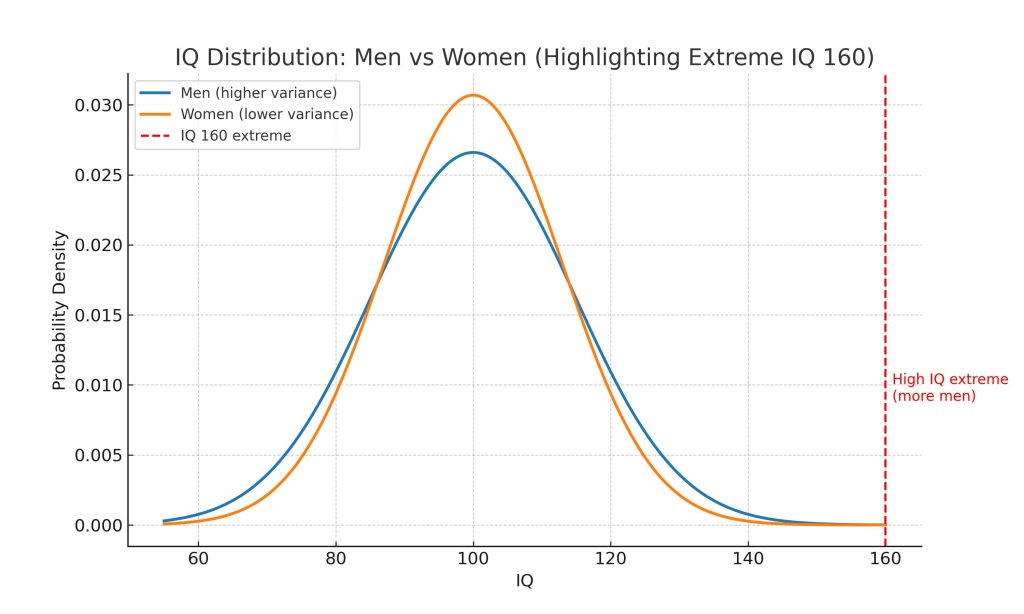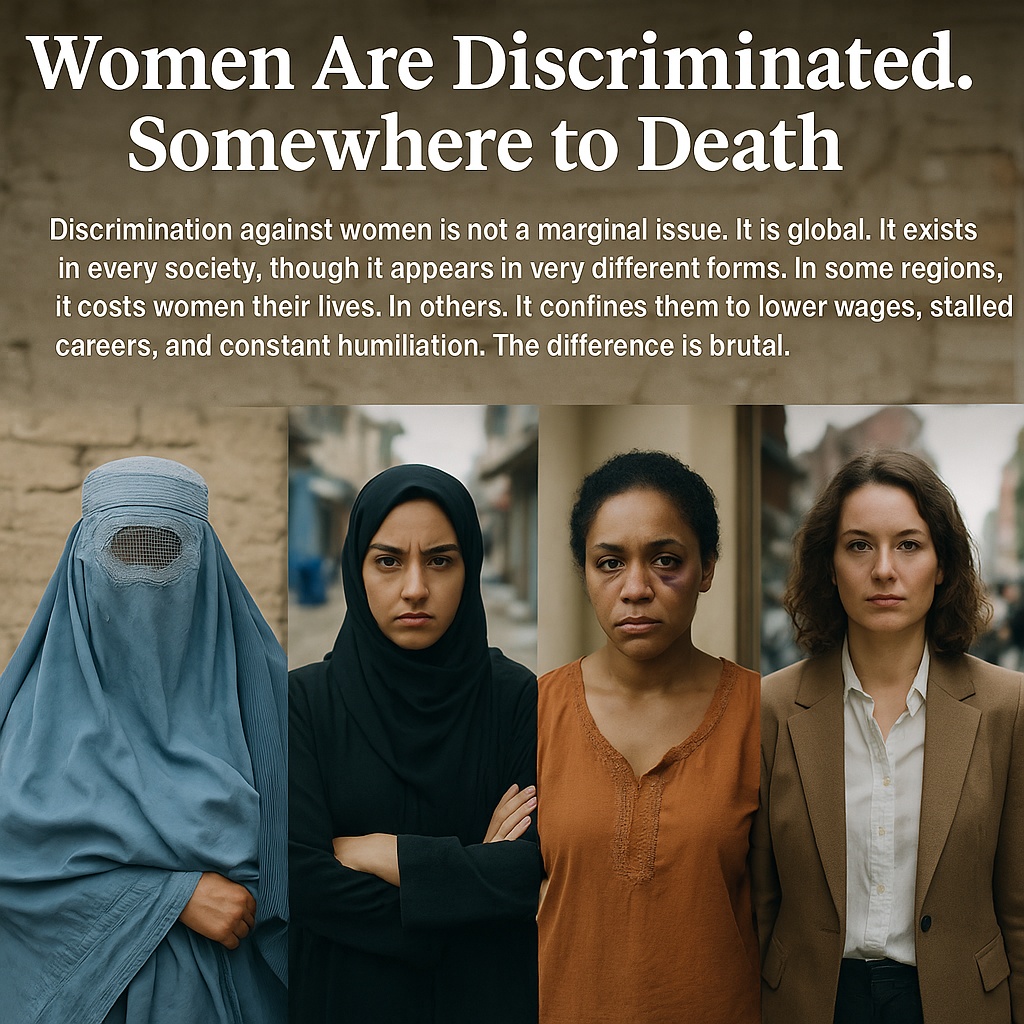Discrimination against women is not a marginal issue. It is global. It exists in every society, though it appears in very different forms. In some regions, it costs women their lives. In others, it confines them to lower wages, stalled careers, and constant humiliation. The difference is brutal.
Afghanistan and Pakistan represent the extreme where discrimination kills. The Czech Republic shows another reality, where discrimination persists but usually stops short of death. By comparing these cases, we see not only how discrimination adapts to culture, law, and power, but also how deep it runs—into history, psychology, and even biology.
Historical roots of female discrimination
Patriarchy did not appear overnight. It has roots in prehistory. Some hunter-gatherer groups had relative gender balance, because survival depended on cooperation. With agriculture came land, inheritance, and accumulation. Men claimed control of property, and women’s status collapsed.
Religion reinforced this shift. Christianity confined women to family and obedience. Islam enshrined segregation and male guardianship. Hinduism tied women to rituals of purity and family honor. Confucian traditions placed women permanently below men in social hierarchies.
Law gave these customs teeth. In Europe, coverture laws erased women’s legal identity into their husbands’. Dowry laws reduced daughters to financial burdens in South Asia. In Islamic states, Sharia became a code of obedience.
What began as resource control hardened into law, faith, and culture—barriers strong enough to last millennia.
Everyday inequality in the modern world
Even today, discrimination defines daily life. Women’s unpaid labor—care, cleaning, child-rearing—remains invisible yet critical. Globally, women earn less than men, even in identical roles.
Education remains unequal. In developing countries, millions of girls never attend school. In developed nations, women are still steered away from mathematics, engineering, and elite sciences.
Health systems discriminate. In poor countries, maternal mortality is catastrophic. In rich countries, medical research often ignores female-specific needs. Reproductive rights are under attack worldwide.
Politics stays tilted. Men dominate parliaments, cabinets, and presidencies. Female politicians are judged for appearance, not policy.
This inequality rarely kills directly. But it creates conditions where women live smaller lives—limited, underpaid, unprotected.
From oppression to violence
When inequality becomes normalized, violence follows.
Domestic abuse is a global epidemic. Many societies still justify it as discipline. Honor killings turn murder into family duty. Female genital mutilation mutilates girls in the name of purity. Child marriages force girls into pregnancies they cannot survive.
Oppression rarely stops at silence. It escalates until it destroys.
Discrimination that kills
Examples of lethal discrimination span the globe.
- South Asia: Dowry deaths kill thousands each year. Women are burned, poisoned, or beaten by in-laws.
- Africa and Asia: Witch-hunts kill widows or poor women accused of sorcery.
- Latin America: Femicide reaches epidemic levels. In Mexico, 10 women are killed every day, often without investigation. In Honduras and El Salvador, women live with constant fear.
- Wars and dictatorships: In Sudan, women protesters are raped and killed. In Iran, women are executed for refusing hijab laws. In Rwanda and Bosnia, rape became a weapon of genocide.
These are not random tragedies. They are systems of death.
Case study: Afghanistan
Afghanistan under the Taliban is the most extreme example. Girls are banned from schools after age 12. Universities are closed to them. Women cannot work in NGOs, businesses, or hospitals. They cannot leave home without a male guardian.
Healthcare becomes a death trap. Female patients cannot see male doctors. Female doctors are not allowed to practice. Women die during childbirth at some of the highest rates in the world.
Resistance brings punishment. Teachers in underground schools are arrested. Women who protest are beaten, jailed, or executed. Afghanistan is not simply unequal. It is a country where law itself becomes a death sentence for women.
Case study: Pakistan
Pakistan’s pattern is different but no less deadly. Dowry deaths are routine. Brides are killed when payments fall short.
Honor killings strike in both rural and urban areas. A father, brother, or husband may murder a woman for speaking to a stranger, choosing her own partner, or seeking divorce. Each year, thousands die.
The justice system rarely protects women. Police dismiss complaints. Courts hand out light sentences or excuse killers if the family forgives. Religious justifications give patriarchy legitimacy. Politicians avoid reforms for fear of losing conservative votes.
Here, discrimination is not hidden. It is public and lethal.
Structural and systemic factors
Such practices endure because systems protect them.
- Impunity: Killers face little punishment.
- Religious dominance: Sharia and custom override rights.
- Economic chains: Poverty forces families into child marriage or trafficking.
- Political cowardice: Leaders avoid reforms that might upset male voters.
- Global complicity: Western states maintain alliances, ignoring abuses for geopolitical gain.
This is not accidental discrimination. It is structural, enforced by law, politics, and economics.
The psychology of discrimination
Discrimination also thrives in psychology. From an evolutionary perspective, men competed for resources and status. Controlling women ensured lineage and inheritance. Over centuries, instincts hardened into culture and law.
Fear still fuels oppression, fear of losing power, fear of dishonor. And fear of women’s independence.
Scientific findings deepen the debate. Most inequalities are cultural, but biology also shapes behavior. For example, the distribution of IQ scores shows men more often at both extremes—brilliant or dysfunctional. Richard Lynn and Paul Irwing (2004) documented that men appear more frequently in the highest IQ ranges, but also in the lowest. This pattern partly explains why men dominate both Nobel Prize lists and prison populations.

Differences emerge even in childhood. Simon Baron-Cohen’s research on “empathizing versus systemizing” found that girls tend to excel in empathy and social cognition, while boys show stronger interest in systems, mechanics, and rules. These tendencies appear early. Alexander and Hines (2002) observed that infant girls gravitate toward dolls, while boys prefer toy cars or balls—even before they understand cultural expectations. Similar results came from Connellan et al. (2000), who found that newborn girls looked longer at human faces while boys focused more on moving objects.
Hormones
Hormones also matter. Testosterone levels influence aggression and risk-taking, while estrogen supports empathy and verbal skills. These effects shape tendencies long before culture intervenes.
Yet nurture builds on nature. A girl may naturally show more empathy, but society channels it into unpaid caregiving instead of leadership. A boy may prefer cars, but culture steers him into engineering while discouraging his sister from joining. Biology sets small biases. Culture turns them into barriers.
This distinction is crucial. Biological variation cannot explain why Afghan girls are banned from schools or why Pakistani brides are burned. Those acts are cultural choices, not genetic imperatives. Biology sets a stage, but society writes the script. Discrimination exploits tiny differences to justify massive inequality.
Case study: Czech reality
Czechia shows another form of discrimination. Women face inequality, but not systemic death.
The wage gap is among the widest in Europe. Women earn significantly less than men, even in identical jobs. Many are pushed into lower-paying fields. Long parental leave removes them from careers, limiting advancement.
Politics is male-dominated. Women in parliament remain underrepresented. Media coverage often mocks or trivializes them. Workplaces still tolerate sexism.
Domestic violence exists but rarely reaches the scale of honor killings or dowry deaths. Femicide happens, but not as a state-sanctioned or cultural norm.
Czech women are discriminated against in salaries, politics, and status. But they are not killed for disobedience. This contrast with Afghanistan and Pakistan is crucial. It shows discrimination can exist without lethal consequences—yet still remain unjust.
Contemporary Resistance
Resistance exists everywhere.
In Afghanistan, women run secret schools. They protest openly despite whips and arrests. Many flee but continue their activism abroad.
In Pakistan, female lawyers and journalists expose dowry deaths and honor killings. Many face threats or assassination attempts. Still, they persist.
In Africa and Latin America, feminists fight femicide. They build shelters, document crimes, and pressure governments.
In Czechia, activists fight quieter battles. They campaign against the wage gap. They push for women in politics. Universities research sexism and propose reforms. Here the fight is about equality, not survival. But it remains vital.
Global contrasts
The world divides sharply.
- In authoritarian and theocratic states, women struggle for survival.
- In democracies, women struggle for equality.
- In Western nations, bias is hidden but persistent.
- In poorer states, violence is open, systemic, and often fatal.
The spectrum is wide. Czechia sits on one end, with wage gaps and structural sexism. Afghanistan stands at the other, with systemic bans and deaths. Pakistan lies between, where discrimination is not absolute but still lethal.
Women discrimination: Conclusion
Discrimination against women takes many forms. In Afghanistan and Pakistan, it kills. In Czechia, it limits. Both grow from the same root: the belief that women are worth less.
Science adds nuance. It shows some differences between men and women are innate. Boys and girls show different preferences from infancy. Men cluster more at IQ extremes. Hormones shape risk, empathy, and aggression. Yet these differences are small. They cannot justify bans, killings, or systemic exclusion.
What societies do is take minor differences and exaggerate them into structures of power. Biology is twisted into ideology.
Until discrimination is dismantled at every level—cultural, legal, economic, and psychological—women will continue to pay the price. In Prague, they pay with smaller paychecks and fewer seats in parliament. In Kabul and Karachi, they pay with their lives.

Leave a Reply